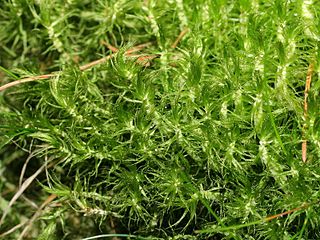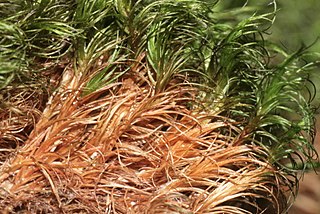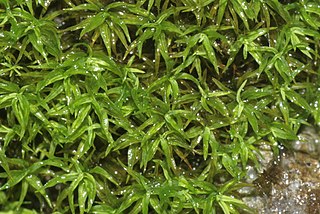| Fissidens | |
|---|---|
 | |
| Fissidens dubius | |
| Scientific classification | |
| Kingdom: | Plantae |
| Division: | Bryophyta |
| Class: | Bryopsida |
| Subclass: | Dicranidae |
| Order: | Dicranales |
| Family: | Fissidentaceae |
| Genus: | Fissidens Hedw. [1] |
| Species | |
See text | |
| Synonyms [1] | |
| |
Fissidens is a genus of over 480 species of haplolepideous mosses (Dicranidae) in the family Fissidentaceae. [1]
Selected species: [1]
- Fissidens acacioides Schrad.
- Fissidens aciphyllus Dixon
- Fissidens acreanus Irmsch.
- Fissidens acrophilus Brugg.-Nann.
- Fissidens adianthoides Hedw.
- Fissidens afropapillosus P.de la Varde
- Fissidens aggestus (Besch.) Paris
- Fissidens ah-pengae Brugg.-Nann.
- Fissidens albolimbatus Dixon
- Fissidens allionii Broth.
- Fissidens allorgei P.de la Varde
- Fissidens alomoides Müll.Hal. ex Dusén
- Fissidens altisetus Dixon
- Fissidens amazonicus Pursell
- Fissidens amoenus Müll.Hal.
- Fissidens amplifolius Dixon & P.de la Varde
- Fissidens andicola (Herzog) Brugg.-Nann.
- Fissidens androgynus Bruch
- Fissidens angustelimbatus Mitt.
- Fissidens angustiusculus Dixon & P.de la Varde
- Fissidens angustus Thwaites & Mitt.
- Fissidens anisophyllus Dixon
- Fissidens annamensis Paris & Broth.
- Fissidens anomalus Mont.
- † Fissidens antiquus Saporta
- Fissidens antrophyi Müll.Hal.
- Fissidens aoraiensis H.Whittier & H.A.Mill.
- Fissidens aphelotaxifolius Pursell
- Fissidens appalachensis R.H.Zander
- Fissidens arboricola Brugg.-Nann.
- Fissidens arcticus Bryhn
- Fissidens argyroloma P.de la Varde
- Fissidens aristifer Brugg.-Nann.
- Fissidens arnigadhensis Broth. ex S.S.Kumar
- Fissidens arnoldi R.Ruthe
- Fissidens artsii Brugg.-Nann.
- Fissidens arunii J.P.Srivast. & Nork.
- Fissidens asplenioides Hedw.
- Fissidens asselii Bizot
- Fissidens autoicus Thér. & Dixon
- Fissidens axilliflorus Thwaites & Mitt.
- Fissidens azoricus (P.de la Varde) Bizot
- Fissidens badyinbarus I.G.Stone
- Fissidens bassilae Alia, Brugg.-Nann. & Reeb
- Fissidens beccarii (Hampe) Broth.
- Fissidens beckettii Mitt.
- Fissidens benitotanii Z.Iwats., K.T.Yong & Tad.Suzuki
- Fissidens berteroi (Mont.) Müll.Hal.
- Fissidens bessouensis Corb.
- Fissidens biformis Mitt.
- Fissidens bifrons Schimp. ex Müll.Hal.
- Fissidens bilaspurensis Gangulee
- Fissidens bilewskyi P.de la Varde
- Fissidens bistratosus Brugg.-Nann.
- Fissidens blechnoides J.E.Beever
- Fissidens bogoriensis M.Fleisch.
- Fissidens bogosicus Müll.Hal.
- Fissidens boninensis Z.Iwats.
- Fissidens borgenii Hampe
- Fissidens bourgaeanus Besch.
- Fissidens brachypus Mitt.
- Fissidens brassii E.B.Bartram
- Fissidens braunii (Müll.Hal.) Dozy & Molk.
- Fissidens brevidorsus Dixon
- Fissidens brevifrons Mitt.
- Fissidens brevinervis Broth.
- Fissidens brevipes Besch.
- Fissidens brindae Pursell & B.H.Allen
- Fissidens bryoides Hedw.
- Fissidens bushii (Cardot & Thér.) Cardot & Thér.
- Fissidens cagoui Frank Müll., Pursell & Brugg.-Nann.
- Fissidens canalae Broth. & Paris
- Fissidens capitulatus Nog.
- Fissidens capriviensis Magill
- Fissidens carnosus Broth.
- Fissidens celticus Paton
- Fissidens ceylonensis Dozy & Molk.
- Fissidens chioneurus Müll.Hal.
- Fissidens chiricahuensis Pursell & B.H.Allen
- Fissidens chitralensis P.de la Varde
- Fissidens circinalis Mitt.
- Fissidens closteri Austin
- Fissidens coacervatus Brugg.-Nann.
- Fissidens compienei Broth. & Paris
- Fissidens consociatus Thér.
- Fissidens costivelatus Brugg.-Nann.
- Fissidens dubius P.Beauv.
- Fissidens elegans Brid.
- Fissidens exilis Hedw.
- Fissidens grandifrons Brid.
- Fissidens hydropogon Spruce ex Mitt.
- Fissidens inconspicuus Mitt.
- Fissidens incurvus Starke ex Röhl.
- Fissidens integerrimus Mitt.
- Fissidens intramarginatus (Hampe) A.Jaeger
- Fissidens intromarginatulus E.B.Bartram
- Fissidens involutus Wilson ex Mitt.
- Fissidens iwatsukii Brugg.-Nann.
- Fissidens jaiorum H.Whittier & H.A.Mill.
- Fissidens jansenii Sérgio & Pursell
- Fissidens javanicus Dozy & Molk.
- Fissidens jeffreyi Bizot
- Fissidens jonesii Bizot
- Fissidens jungermannioides Griff.
- Fissidens jungermanniopsis Müll.Hal.
- Fissidens juruensis Broth.
- Fissidens kalimpongensis Gangulee
- Fissidens kamiyamae Tad.Suzuki & Z.Iwats.
- Fissidens kammadensis Manju, K.P.Rajesh & Madhus.
- Fissidens karataviensis Samsel
- Fissidens karwarensis Dixon
- Fissidens kiguchii Tad.Suzuki
- Fissidens kilaueae Hoe & H.A.Crum
- Fissidens kinabaluensis Z.Iwats.
- Fissidens kondoi Sakurai
- Fissidens kosaninii Latzel
- Fissidens kurzii Müll.Hal.
- Fissidens lachmannii Bizot
- Fissidens lagenarius Mitt.
- Fissidens lancifolius E.B.Bartram
- Fissidens laosianus Dixon
- Fissidens latelimbatus Brugg.-Nann.
- Fissidens lateriticus K.M.Manjula, Manju & K.P.Rajesh
- Fissidens lautokensis Dixon
- † Fissidens microstictus Dixon & Luisier
- Fissidens polypodioides Hedw.
- Fissidens pusillus (Wilson) Milde
- Fissidens serratus C.Müller
- Fissidens taxifolius Hedw.
- Fissidens usambaricus Broth.

















